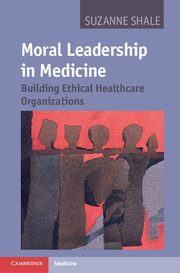Book contents
- Frontmatter
- Contents
- Preface
- Acknowledgements
- Chapter 1 Why medicine needs moral leaders
- Chapter 2 Creating an organizational narrative
- Chapter 3 Understanding normative expectations in medical moral leadership
- Prologue to Chapters 4 and 5
- Chapter 4 Expressing fiduciary, bureaucratic and collegial propriety
- Chapter 5 Expressing inquisitorial and restorative propriety
- Epilogue to Chapters 4 and 5
- Chapter 6 Understanding organizational moral narrative
- Chapter 7 Moral leadership for ethical organizations
- Appendix 1 How the research was done
- Appendix 2 Accountability for clinical performance: individuals and organizations
- Appendix 3 A brief guide to commonly used ethical frameworks
- Index
Prologue to Chapters 4 and 5
Published online by Cambridge University Press: 05 January 2012
- Frontmatter
- Contents
- Preface
- Acknowledgements
- Chapter 1 Why medicine needs moral leaders
- Chapter 2 Creating an organizational narrative
- Chapter 3 Understanding normative expectations in medical moral leadership
- Prologue to Chapters 4 and 5
- Chapter 4 Expressing fiduciary, bureaucratic and collegial propriety
- Chapter 5 Expressing inquisitorial and restorative propriety
- Epilogue to Chapters 4 and 5
- Chapter 6 Understanding organizational moral narrative
- Chapter 7 Moral leadership for ethical organizations
- Appendix 1 How the research was done
- Appendix 2 Accountability for clinical performance: individuals and organizations
- Appendix 3 A brief guide to commonly used ethical frameworks
- Index
Summary
In the next two chapters I shall be arguing that an important element in the practice of moral medical leadership is distinctive patterns of behaviour giving effect to important values. I call these patterns of behaviour ‘propriety’, and I shall be examining five such ways of acting: fiduciary propriety, bureaucratic propriety, collegial propriety, inquisitorial propriety and restorative propriety.
Propriety makes an important contribution towards the work of orchestrating organizational moral narrative, demonstrating approved ways of acting and signalling significant moral commitments. But medical leaders owe many overlapping moral responsibilities, and have to take into account the multiple needs of different individuals and different groups at different times. The complexity of their moral responsibilities occasionally results in the emergence of apparently irreconcilable aims and contradictory moral goods. There are insoluble moral tensions to be found at the heart of medical management and these come to the surface, I believe, in conflicting proprieties.
- Type
- Chapter
- Information
- Moral Leadership in MedicineBuilding Ethical Healthcare Organizations, pp. 92 - 98Publisher: Cambridge University PressPrint publication year: 2011



